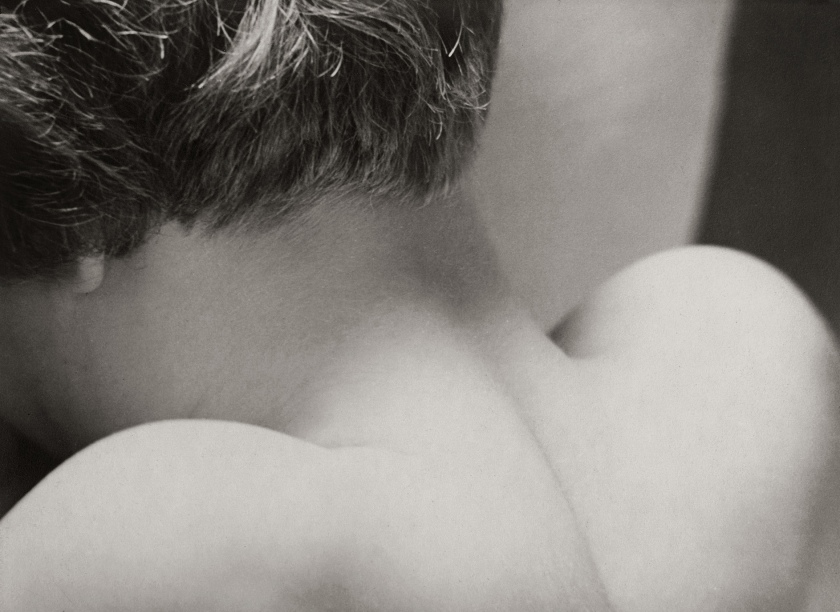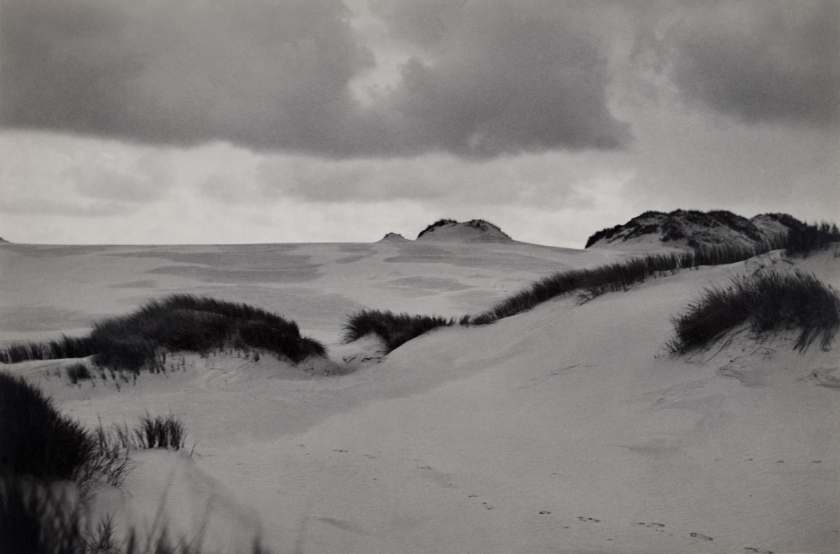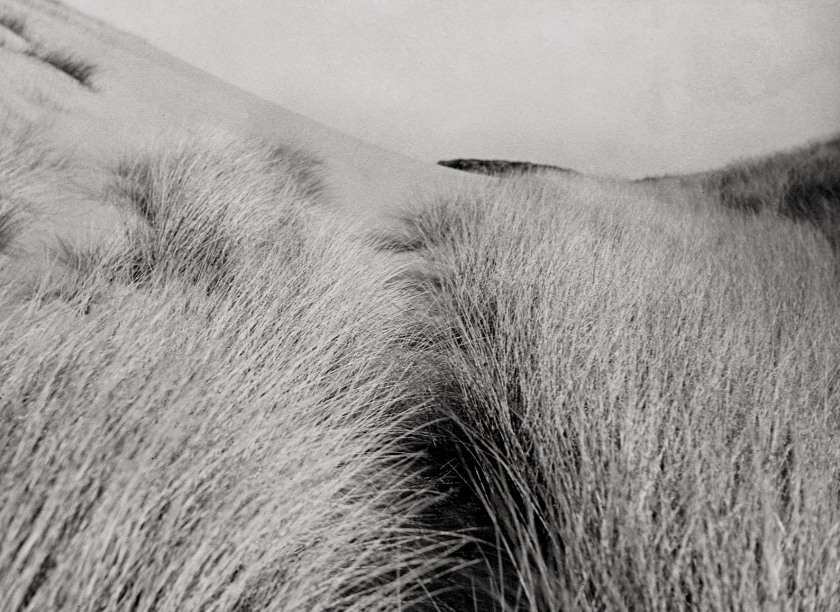Exhibition dates: 6th February – 20th May 2018
Curator: Cécile Bargues
Raoul Hausmann (Austrian, 1886-1971)
Untitled (Vera Broïdo)
c. 1931
© ADAGP, Paris, 2018
© Berlinische Galerie – Landesmuseum für Moderne Kunst, Fotografie und Architektur/VG Bild-Kunst, Bonn
Spirit of his time?
Surrealism, solarisation, mobiles, photomontage, geometric repetition and simplification of form, directional lighting, distortion, female allusions, strong use of diagonals, romanticism, poetics. All the usual tropes of the photographic art of the day are present, but somehow the images never move me, or impinge lastingly on my consciousness.
Hausmann’s work sits at the intersection of New Vision (the development of photography as a medium of untold expressive power and as a primary vehicle of modern consciousness) and New Objectivity (a sharply focused, objective documentary quality; a movement in German art that arose during the 1920s as a reaction against expressionism) photographic movements. The interstices of freedom and wonder, which he referred to as ‘beauty without beauty’, both experimental and ‘classical’ at the same time.
I’m not convinced. “His images of plants, sea spray, changing light and materials, are images of disorder, stripped of all authoritarian vision.” Really? To me his work seems very authoritarian… very male, very objective but subjected to the photographers’ will. Triumph of the Will.
I’d rather look at the infinitely more interesting female artists of the era, for example Eva Besnyö, Claude Cahun, Germaine Krull or Florence Henri to name but a few. Now they were cooking with gas!
Dr Marcus Bunyan
Many thankx to Jeu de Paume for allowing me to publish the photographs in the posting. Please click on the photographs for a larger version of the image.
To this day, Raoul Hausmann’s photography has not had a dedicated museum exhibition in France. As a photographer, Hausmann has long remained underrated and unheralded. However his key position in 20th century avant-garde photography has continually been re-evaluated and his importance is widely acknowledged these days.
We know Hausmann as the prominent artist of Dada Berlin, as the author of assemblages, collages, lautgedichte, etc, yet the vicissitudes of history caused the obliteration of his photography, an essential facet of his œuvre. From 1927 onwards Hausmann became an avid and restless photographer. His photographic practice quickly became a cornerstone of his multi-faceted reflections and activities, pushing him in a new direction which culminated in his forced departure from Ibiza in 1936.
Considering Hausmann’s clandestine crossing of the century, it is no surprise that his photographic œuvre was forgotten. Labelled a ‘degenerate’ artist by the Nazis, he hastily left Germany in 1933. As an exile, Hausmann suffered the dispersion, and sometimes the destruction, of his work. His photography was seldom displayed and survived unnoticed until the late seventies. It was long supposed to be lost, until an archive (now at the Berlinische Galerie) was almost miraculously discovered at his daughter’s home after her death.
Raoul Hausmann (Austrian, 1886-1971)
Untitled (Dune Landscape)
Between 1927 and 1933
© ADAGP, Paris, 2018
© Berlinische Galerie – Landesmuseum für Moderne Kunst, Fotografie und Architektur/VG Bild-Kunst, Bonn
Raoul Hausmann (Austrian, 1886-1971)
Enfants de la Frise (Children of Friesland)
Between 1927 and 1933
© ADAGP, Paris, 2018
© Berlinische Galerie – Landesmuseum für Moderne Kunst, Fotografie und Architektur/VG Bild-Kunst, Bonn
Raoul Hausmann (Austrian, 1886-1971)
Nu sur la plage (Nude on the beach)
Between 1927 and 1933
© Musée d’art moderne et contemporain de Saint-Étienne Métropole
© ADAGP, Paris, 2017
Raoul Hausmann (Austrian, 1886-1971)
Untitled (Chrysanthemum flower)
Between 1927 and 1933
© ADAGP, Paris, 2018
© Berlinische Galerie – Landesmuseum für Moderne Kunst, Fotografie und Architektur/VG Bild-Kunst, Bonn
Highlights of the exhibition
1/ Raoul Hausmann was a central figure of the Berlin Dada movement, a pioneer of sound poetry, who spearheaded collage and photomontage. He was also a writer, editor, and experimenter across all genres. Franz Jung referred to him as a ‘cultural agitator of 1920s’ Berlin’. In the late 1930s, Hausmann was also a passionate, prolific, sensitive and lyrical photographer. Bringing together over 130 vintage prints, all produced by Hausmann himself, this exhibition presents a photographic oeuvre that has remained unrecognised and unheralded for too long
2/ This is the first time that Hausmann’s photographic work has been the subject of such an extensive retrospective in France. The exhibition opens at the Point du Jour in Cherbourg, before coming to the Jeu de Paume. ‘Raoul Hausmann. Vision in Action’ benefits from a number of exceptional loans, from institutions boasting collections of work by the artist, primarily the Musée départemental d’art contemporain de Rochechouart and the Berlinische Galerie; collections that continued to grow until relatively recently. Other first-rate public and private collections, both in France and Germany, have contributed to the exhibition, with some work being displayed for the first time
3/ In 1931, Hausmann considered himself a photographer. His practice was honed far from Berlin, in the dunes of the Baltic and the North Sea. An emotive photographer, capturing remarkable moments or sights on his numerous walks, he never sought the perfection of an overly immaculate image, seamlessly constructed and arranged, but rather the interstices of freedom and wonder, which he referred to as ‘beauty without beauty’. This sense of calm or tranquillity can be seen in the way his work has resisted and maintained its dignity, against the ravages of time
4/ Within the space of an intense decade – from 1927 until his forced departure in 1936, from the island of Ibiza, where he had sought refuge in 1933, shortly after the Nazis’ rise to power – Raoul Hausmann produced over a thousand prints, many of which were published or exhibited in their day, before taking up residence in the archives of memory. These images and their diffusion situated him in a specific milieu – Germany, Paris (where he spent time in 1935), and later in Czechoslovakia (the only retrospective devoted to the artist’s work during his lifetime was held in Prague, in 1937). Hausmann’s work incites the public to reflect upon a network and history of photography, inhabited by figures such as August Sander, Raoul Ubac, László Moholy-Nagy, etc
5/ At the crossroads of the New Vision and New Objectivity photographic movements, Raoul Hausmann’s work is constructed within a poetics of distance or difference with regard to normality. Both experimental and ‘classical’ at the same time, he liked nothing better than resolving and surpassing oppositions. His sublime sculptural and mineral nudes contrast with the monstrosity of the Nazi body. His images of plants, sea spray, changing light and materials, are images of disorder, stripped of all authoritarian vision. In all respects, this photography, produced using a bare minimum of equipment, serves a project of a heightened existence
6/ Hausmann reflected about the social and political uses of images, particularly in Ibiza, in his work on vernacular architecture, an inventory of buildings that aimed to invalidate the idea of ‘origin’ and ‘race’. This project around the notion of habitat, in the philosophical sense of the term, responds ultimately, like the ensemble of his work, to the maxim that underlines his oeuvre: ‘you alone should construct the limits of your universe’.
Raoul Hausmann (Austrian, 1886-1971)
Untitled (Foot in the sand)
c. 1931
© ADAGP, Paris, 2018
© Berlinische Galerie – Landesmuseum für Moderne Kunst, Fotografie und Architektur/VG Bild-Kunst, Bonn
Raoul Hausmann (Austrian, 1886-1971)
Untitled (Dune grass)
c. 1931
© ADAGP, Paris, 2018
© Berlinische Galerie – Landesmuseum für Moderne Kunst, Fotografie und Architektur/VG Bild-Kunst, Bonn
Raoul Hausmann (Austrian, 1886-1971)
Petite Fleur en Herbe [Small flower in grass]
1932
Photomontage
© ADAGP, Paris, 2018
© Berlinische Galerie – Landesmuseum für Moderne Kunst, Fotografie und Architektur/VG Bild-Kunst, Bonn
Raoul Hausmann (Austrian, 1886-1971)
Untitled (Thistle)
1932
© ADAGP, Paris, 2018
© Berlinische Galerie – Landesmuseum für Moderne Kunst, Fotografie und Architektur/VG Bild-Kunst, Bonn
Raoul Hausmann (Austrian, 1886-1971)
Dune mobile
September 1931
© ADAGP, Paris, 2018
© Berlinische Galerie – Landesmuseum für Moderne Kunst, Fotografie und Architektur/VG Bild-Kunst, Bonn
Raoul Hausmann (Austrian, 1886-1971)
Deux nus féminins allongés sur une plage (Two naked women lying on a beach)
c. 1931-1934
© ADAGP, Paris, 2017
Photo: © Centre Pompidou, MNAM-CCI. Dist. RMN-Grand Palais/Guy Carrard
Raoul Hausmann (Austrian, 1886-1971)
Untitled
1931
© Musée départemental d’art contemporain de Rochechouart
Raoul Hausmann (Austrian, 1886-1971)
Regard dans le miroir
1930
© Musée départemental d’art contemporain de Rochechouart
Raoul Hausmann (Austrian, 1886-1971)
Untitled
1931
© Musée départemental d’art contemporain de Rochechouart
Raoul Hausmann (Austrian, 1886-1971)
The Triangle (Vera Broïdo)
c. 1931
Coll. Marc Smirnow
© ADAGP, Paris, 2017
Raoul Hausmann (Austrian, 1886-1971)
The Triangle (Vera Broïdo) (Alternate version)
c. 1931
To this day, Raoul Hausmann’s photography has not had a dedicated museum exhibition in France. As a photographer, Hausmann has long remained underrated and unheralded. However his key position in 20th century avant-garde photography has continually been re-evaluated and his importance is widely acknowledged these days.
We know Hausmann as the prominent artist of Dada Berlin, as the author of assemblages, collages, lautgedichte, etc, yet the vicissitudes of history caused the obliteration of his photography, an essential facet of his oeuvre. From 1927 onwards Hausmann became an avid and restless photographer. His photographic practice quickly became a cornerstone of his multi-faceted reflections and activities, pushing him in a new direction which culminated in his forced departure from Ibiza in 1936.
Between 1927 and 1936, Hausmann engaged in a discussion about the nature and the role of photography with August Sander. He published a body of theoretical texts and was part of a group that included such notorious figures as Raoul Ubac, Man Ray, Elfriede Stegemeyer, and Lázló Moholy-Nagy. The latter once stated: ‘All that I know, I’ve learnt it from Raoul’.
Considering Hausmann’s clandestine crossing of the century, it is no surprise that his photographic oeuvre was forgotten. Labelled a ‘degenerate’ artist by the Nazis, he hastily left Germany in 1933. As an exile, Hausmann suffered the dispersion, and sometimes the destruction, of his work. His photography was seldom displayed and survived unnoticed until the late seventies. It was long supposed to be lost, until an archive (now at the Berlinische Galerie) was almost miraculously discovered at his daughter’s home after her death.
The French photographic archive of Hausmann’s work, kept mainly at the Musée de Rochechouart and opened in 1985, continued to grow up until 2010. This institutionalisation of his work has generated an on-going re-appraisal. Hausmann the photographer is astonishing. In contrast to the sarcastic and biting tone generally associated with his Dada period, his photographs are a means to pacification. They convey a sense of reconciliation, a serenity that did not prevail before. In the late twenties Hausmann felt more and more oppressed in Berlin. He took long vacations in small villages by the North Sea and the Baltic, villages described by his partner Vera Broïdo as ‘shelters’ and ‘hide-outs for artists’. There, he took photographs of the sand, the foam, the bogs, trees, naked bodies, curvy dunes, wheat, weeds, insignificant things that dazzled him. His attention also focused on humble objects, cheese graters, cane woven chairs, wicker baskets, which he transformed through the use of light and shadow. Hausmann calls these experimentations ‘melanography’. They strikingly exemplify his definition of what an image is: ‘the dynamics of a living process’.
Hausmann’s arrival in Ibiza in 1933, shortly after the Reichstag fire, opened a new perspective. Fascinated by the peasant houses built in the shape of white cubes, he began a photographic inventory of this ‘architecture without architects’. Photography became partly a study dedicated to vernacular architecture from an anthropological point of view. Hausmann also discussed notions such as ‘origin’ or ‘race’ that emerged in contemporary architectural circles. Fully integrated in the island’s life, he lived in a ‘state of dream’, as if outside time. Hausmann also pursued a project begun in Germany that revolved around two broad categories, portraits and the vegetational or organic forms. The outbreak of the Spanish Civil War, in which he briefly took part as a Republican (Ibiza being the first territory abandoned to the Francoists as early as 1936), marks the beginning of his wandering across Europe. During his exile, Hausmann no longer had the possibility of dedicating himself so passionately to photography.
Text from Jeu de Paume press kit
Raoul Hausmann (Austrian, 1886-1971)
Monsieur Mariano Ribas
1933
@ Musée départemental d’art contemporain de Rochechouart
Raoul Hausmann (Austrian, 1886-1971)
Peasant house (Can Rafal)
1934
© Musée départemental d’art contemporain de Rochechouart
Raoul Hausmann (Austrian, 1886-1971)
Three chairs
1934
© Musée départemental d’art contemporain de Rochechouart
Marthe Prévôt (b. 1923)
Raoul Hausmann tenant sa sculpture-assemblage L’Esprit de notre temps
Raoul Hausmann holding his sculpture-assembly The Spirit of our time
1967
© Documentation du Musée départemental d’art contemporain de Rochechouart
August Sander (German, 1876-1964)
Raoul Hausmann en danseur
1929
© Die Photographische Sammlung/SK Stiftung Kultur – August Sander Archiv, Cologne, ADAGP, Paris, 2017
August Sander (German, 1876-1964)
Inventor and Dadaist (Raoul Hausmann)
1929, printed 1990
Silver gelatin print
258 x 193mm
Tate and National Galleries of Scotland. Lent by Anthony d’Offay
Jeu de Paume
1, Place de la Concorde
75008 Paris
métro Concorde
Phone: 01 47 03 12 50
Opening hours:
Tuesday: 11.00 – 21.00
Wednesday – Sunday: 11.00 – 19.00
Closed Monday



![Raoul Hausmann (Austrian, 1886-1971) 'Enfants de la Frise [Children of Friesland]' Between 1927 and 1933 Raoul Hausmann (Austrian, 1886-1971) 'Enfants de la Frise [Children of Friesland]' Between 1927 and 1933](https://artblart.files.wordpress.com/2018/02/hausmann-6-web1.jpg?w=840)
![Raoul Hausmann (Austrian, 1886-1971) 'Nu sur la plage [Nude on the beach]' Between 1927 and 1933 Raoul Hausmann (Austrian, 1886-1971) 'Nu sur la plage [Nude on the beach]' Between 1927 and 1933](https://artblart.files.wordpress.com/2018/02/hausmann-18-web1.jpg?w=840)



![Raoul Hausmann (Austrian, 1886-1971) 'Petite Fleur en Herbe [Small flower in grass]' 1932 Raoul Hausmann (Austrian, 1886-1971) 'Petite Fleur en Herbe [Small flower in grass]' 1932](https://artblart.files.wordpress.com/2018/02/hausmann-4-web.jpg?w=650&h=831)


![Raoul Hausmann (Austrian, 1886-1971) 'Deux nus féminins allongés sur une plage [Two naked women lying on a beach]' c. 1931-1934 Raoul Hausmann (Austrian, 1886-1971) 'Deux nus féminins allongés sur une plage [Two naked women lying on a beach]' c. 1931-1934](https://artblart.files.wordpress.com/2018/02/raoulhausman-20-web.jpg?w=840)











You must be logged in to post a comment.